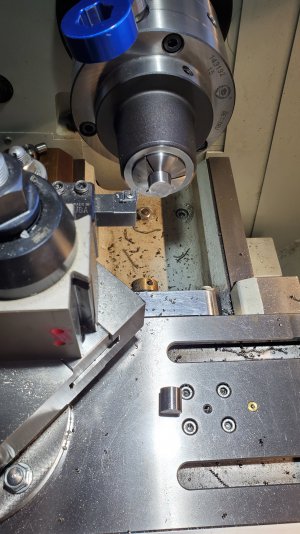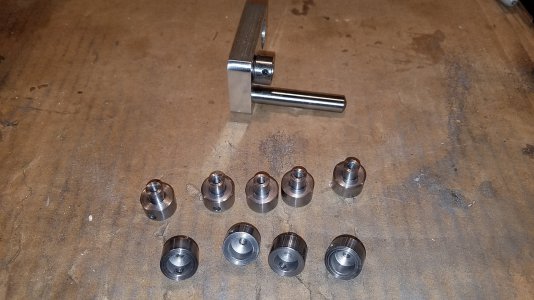- Joined
- Jun 12, 2014
- Messages
- 4,826
I make pieces similar to these using 5/8" 01 steel rod, typically in batches or 10-15. Each piece is 5/8" long. Just did a dozen the other day. Final tolerances are within 0.001", step diameter is 0.300". First I cut the rod into segments slightly over the desired length, I use a bandsaw with a stop to cut them all to the same length. I then face off one end using a 5C collet in the lathe, flip them and then face the other end. I have both collet stop systems and through the spindle stop systems for exact length tolerances. Then I center drill the part, there are two separate hole diameters on my parts and one end is threaded. I then put the part in a square 5C holder and bring it to the mill to drill/tap a shaft set screw hole, I use a stop system so the hole location is not affected by the 5C clamping. Then back to the lathe and do the shoulder, then tap the center. In my case there are 8 or 9 steps, so it does become important that the chuck has minimal run-out, I use a Set-Tru Bison. With my previous 5C chucks I did have a 0.002-0.003" variability in clamping distance when using a screw in collet stop system, with the Bison the variability is typically less than 0.001". A through the spindle stop system is more reproducible/accurate.
In your case for the half-moon on the end I would do it in the mill, probably use a annular cutter depending on the radius. I would do it after cutting the shoulder to reduce the amount of material removal. Softer materials one could use an end mill. I use 5C collets for this type of work, I can rigidly hold stock as short as 1/4" and it will remain aligned. Standard 3J chuck, just not possible and the parts tend to twist. I would not use PVC, it is weak and shatters, softer plastics will probably distort and may slip of of the collet. You need sharp tooling for cutting plastics. Agree a 3D printer would be optimal choice, maybe outsource or see if you can get a HM member to do a bunch for a nominal amount. I do a bit of work with phenolic materials, they have rod material and it machines reasonably well. I use the linen based phenolic material, not a big fan of the glass fiber impregnated stuff.

 www.mcmaster.com
www.mcmaster.com


In your case for the half-moon on the end I would do it in the mill, probably use a annular cutter depending on the radius. I would do it after cutting the shoulder to reduce the amount of material removal. Softer materials one could use an end mill. I use 5C collets for this type of work, I can rigidly hold stock as short as 1/4" and it will remain aligned. Standard 3J chuck, just not possible and the parts tend to twist. I would not use PVC, it is weak and shatters, softer plastics will probably distort and may slip of of the collet. You need sharp tooling for cutting plastics. Agree a 3D printer would be optimal choice, maybe outsource or see if you can get a HM member to do a bunch for a nominal amount. I do a bit of work with phenolic materials, they have rod material and it machines reasonably well. I use the linen based phenolic material, not a big fan of the glass fiber impregnated stuff.
McMaster-Carr
McMaster-Carr is the complete source for your plant with over 595,000 products. 98% of products ordered ship from stock and deliver same or next day.




